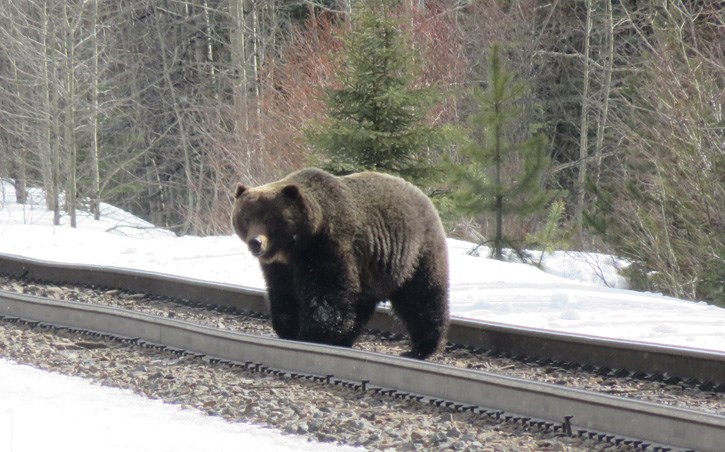BANFF – A large grizzly bear, believed to be the Boss, is out and about.
The bear was caught on camera last Tuesday (March 19) in an area Parks Canada had put out a road kill carcass in an attempt to intercept any bears heading down the railway tracks towards the site of a train derailment that spilled grain near Banff.
Parks Canada officials say the diversionary feeding plan aims to “buy us time” while Canadian Pacific Railway finishes cleaning up the spilled grain – a major attractant for bears in spring as they head out of hibernation.
“We put some meat out to hopefully hold bears from coming down the railway tracks towards where the derailment is,” said Bill Hunt, resource conservation manager for Banff National Park.
“We don’t know for sure which bear it is, but we’re guessing it is No. 122 [a.k.a The Boss]. We’ve put out another bit of carcass recently and he was still in the area – but we know that’s a stop gap measure.”
The Feb. 28 derailment saw 21 cars crash off the tracks across a 300-metre area, 11 of which were empty and another 10 carrying canola, which is a calorie-rich source of food that draws bears to the tracks each year.
The location, about seven kilometres west of Banff near Backswamp, is a hot spot for bears heading out of their dens each spring looking for an easy meal of animal carcasses and grain along the train tracks.
Hunt said CP has removed all of the grain cars and is now working on vacuuming up residual grain.
In addition, he said two fences, which have been electrified on the outside, have been built to try to keep bears from getting into the site.
“Electrification of the fence has been tested regularly and we’re happy with the voltage,” he said, noting CP has cameras on site and checks it each morning to see if bears have visited overnight.
“We all know bears can dig under fences. They’re powerful animals and they’re motivated and will investigate. The ideal situation would be, even if a bear were able to get inside fence, there wouldn’t be a substantial food reward in there.”
Hunt notes the diversionary feeding strategy won’t work much longer.
“We were very lucky to intercept one grizzly bear, but this only buys us a number of days and it’s not going to deter bears from discovering the site,” said Hunt.
“We have two black bears active, based on collar data, and we know other bears are emerging.”
Meanwhile, a black bear was spotted at the site of the Feb. 4 freight train derailment near Field, B.C., which left three Canadian Pacific Railway crew dead.
Lesley Matheson, a Parks Canada spokesperson for Yoho National Park, said CP reported staff had seen a bear on the tracks in the area near the Spiral Tunnel, noting CP and its contractors also had camera footage of a black bear in the area Sunday evening (March 24).
“Parks Canada continues to work with CP to ensure the grain spill is cleaned up in a timely and effective manner,” she said.
Salem Woodrow, a spokesperson for CP, said there is no evidence bears were feeding on grain.
“Crews did not witness, nor was there evidence to suggest, a bear was feeding on grain,” she said.
Since 2000, 17 grizzly bears have been killed on the train tracks in Banff and Yoho national parks, which is a significant blow to Banff’s population of about 60 grizzlies.
Train strikes are the leading cause of death of the threatened species in this area.
With bears emerging from their dens, Parks Canada reminds people to carry bear spray and know how to use it, travel in groups, keep dogs on a leash and makes lots of noise.
“Bear season has begun, and we really encourage people to get themselves into bear mode,” said Hunt, adding the number to call to report bear sightings is 403-762-1470.
Last year, the first sighting of No. 122 was on March 24 along the Bow Valley Parkway. In 2016, he was out as early as March 5.




